Checking the seven-day weather forecast (or meteo) for Paris my wife, Grace, discovered that we were in for a -1 degree celsius temperature around Saturday. We realized that winter is coming, especially this evening when we found ourselves chilled enroute from a very last-minute grocery shopping at FranPrix in Le Marais. When we exited the grocery a desperate, and obviously hungry old beggar (who spoke in a strange language of plea) tapped Grace on the shoulder which prompted us to break into a faster trot. It was the first time a mendicant had approached us that close, and with an insistence that he even followed us to the corner of rue Saint-Antoine. Grace expressed how she disliked Le Marais in St. Paul because of the way the homeless had encamped in the passageways and alleys and also because they looked more and more dangerous as the weather became unbearably colder.
But compassion was nevertheless yanked from our wary minds when we saw an old woman in bundled clothing had prepared her bedding of cardboard boxes and old clothes along the corridors of the building of Cité des Arts. If we were freezing, how much unbelievably colder weather will the homeless endure...outdoors at night? (I saw a beggar at Bir Hakeim station showing off his frost-bitten and toe-less feet) Perhaps this is the reason, I said, why the old man had pleaded so desperately: these nights are a terror for those without shelter or food. Yet, unfortunately I said we cannot indulge our compassion needlessly. Marguerite had informed me that the government is taking some steps in aiding the homeless, who are generally part of the thousands of Roman (Romanian) families, to return to their hometowns but they keep on coming back to Paris, and its troves of tourists. I am sure, based on experience in "helping" that even a single act of "mercy" will cause them to hurl at you and demand for more, and with increasing frequency bordering on some form of extortion. Besides, we are from a relatively poor country, what moral right do we have to give alms here when we cannot help the poor in our hometown or neighborhood? But the issue is very thorny and I do not have the right answers, nor the moral ascendancy to do so.
They call it the Disneyland effect, when tourists come to Paris as if it was a theme park cordoned off for our amusement. To be frank, I fell for this illusion on my first few days. But this was immediately dispelled when I saw vagrants and the homeless camping right next to the door of Cité de Arts, complete with their luggage and backpacks - like perpetual hikers and wanderers of the world. Today I saw a Chinese artist sketching a beggar near Jardin de Luxembourg. How crazy it seemed, that the elderly Asian artist accurately captured the dismal form of the penniless, from the heated comfort of a café while his subject shuddered under a tree, sitting on the pavement.
But its not the mendicants who deliver to me the most truth versus the fallacy of the Disneyland effect. This distinction belongs to other groups of street persons: the hustlers and scammers, the turnstile jumpers and the outright thieves.
Those who have given me ample advice about life in Paris for my three month sojourn mentioned in strong empathic tones of the proficiency of pickpockets and hustlers in Paris. On my first day alone, while admiring the sculptures of Maillol at the Jardin de Carousel, I was hounded by girls with petition papers asking for my signature for some vague UNICEF project. When I asked what the project was (they feigned to know English) they just pointed the figure of 20€ as donation. I told them I cannot help them because it seemed unrealistic that UNICEF would hire quite young children to solicit funds from the street. They broke into this medley of gibberish and I reached for my coat pocket to make sure they could not pilfer anything as I strode to the nearest roving police officer. At the sight of the blue-uniformed policeman, they suspiciously disappeared. This happened again while I was in front of Hotel de Ville and a burly man bothered me while I was inspecting a figure of a sculpture that he needed some change for 10€ to give as alms for a charity. He presented a publication to me and said it was "for bebe, for bebe". When I said I didnt have money on me, he said "money for bebe, for bebe" and I saw in his eyes the excitement of a hunter aimed at his prey and told him he was annoying me and I will call the police if he doesn't get out of my face. When a companion came close I warned him as well that I will point them out as thieves and both went away muttering.
That was the only day I hated Paris. But I was not alone. Marguerite had her phone stolen by a Romanian boy who pretended to be mute and shoved a petition paper to her face while he pocketed her smartphone that lay on the bistrot table.
But as the days went by I discovered more schemers and hustlers.
Near the Louvre, and at Pont Neuf I've noticed four men stooping to pick up the same sized rings within the span of 15 minutes and asked several couples if they lost their bands. Obviously, a scam.
At the foot of Butte Montmartre Ive seen some tourists' hands being tied up with colored strings by fellows who loudly claim "no buy, I am friend". But the same line was being repeated by the other men at different levels of the steps so it must be nothing but another scam. Same with the three-way monte card games played near the Eiffel, or the vicinities of Moulin Rouge: all forms of cheating and diversionary tactics for pickpocketing.
Where are the police?
Well, one afternoon at the Trocadero I witnessed a policeman lunge at an illegal ambulant vendor of Eiffel Tower trinkets and both wrestled on the marble floor while the others scampered away, but just barely. The vendor slipped out of the policeman's grasp and away he went to his band of friends and fled. The policeman picked himself up, spoke to his partner and left smiling. Ten minutes later the vendors were back and even sold some of their goods to the same gullible tourists who had witnessed the fracas!
But that was it. Of all my weeks spent in Paris, I saw only one intervention vis-a-vis the daily dose of being pestered by petition papers, trinket sellers, friendship band makers, ring bearers, Metro kangaroos (how they can jump that high across the turnstile was so fascinating) and residents of telephone booths and building corridors.
I thought that by going out of the metropolis that I would be spared of meeting these characters. But there they were even in tiny Lisieux, with cups in their hands and brawny shoulders asking for alms at the gates of the Basilique, the Carmel, and in the narrow streets of Rouen. With these men my wife and I are incensed: they are obviously burly enough to work!
But when Ive read articles about this phenomena, I discovered that not many opportunities are available to non-local migrants despite that some (like the Roman) are European citizens. The previous administration under Sarkozy had a policy of repatriation but these hardy men and women are holding out until that policy ends in 2013. Meanwhile the tourist forums and travel blogs are choked with complaints of being accosted by the police by stepping on the grass even as they protest as being targeted by thieves and scammers.
I believe I will witness more of these as the weeks roll into December and Christmas. Back home I can imagine that our own version of the dispossessed roam the streets for alms, or sing weird Christmas tunes in a dialect in the narrow aisles of jeepneys, or huddle in parks, plazas to share their gleanings with the rest of their group.
But that sight, I am used to. What bewilders me is the spectacle of a bearded man in his late years, dressed in a passably clean white coat, lying down in a bed of cartons and Sycamore leaves, reading a book, in the well lighted passageway of a closed magasin. For a Filipino who was raised to see his gods and saints as white men, I cannot help but feel depressed.
Paris may have its own Disneyland, but certainly it is not a theme park.
It is an urban city, a living, constantly changing and certainly self-contradicting metropolis catering to all range of races, classes and types of human beings. How many people who live here can truly call it home, without walls around them? How many people can claim to have seen Paris without being seen in return? How many people can traverse its streets, think of midnights and magic and romance films, while clutching to their wallets and phones with uneasy vigilance? How many can, indeed, go back to their countries and show their dumbfounded neighbors and friends of the picturesque beauty of Paris while trying hard to frame out those who linger at the periphery, the margins?
I will certainly not make a pretty frame when I get back. It is impossible.
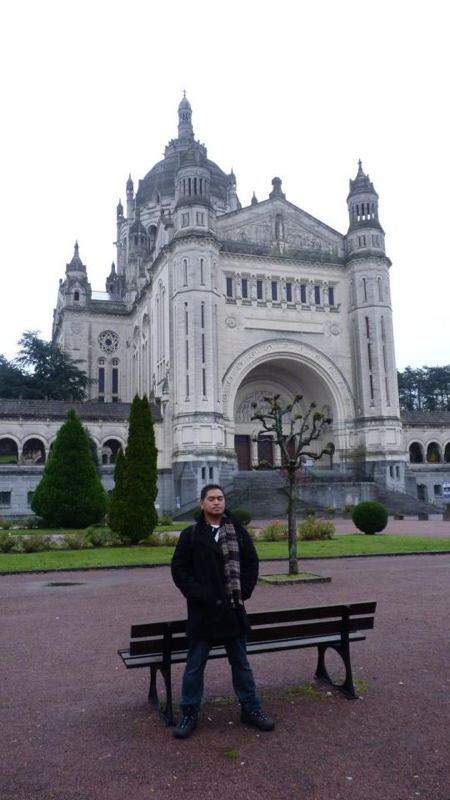
Basilica of St. Therese,Lisieux, Basse-Normandie
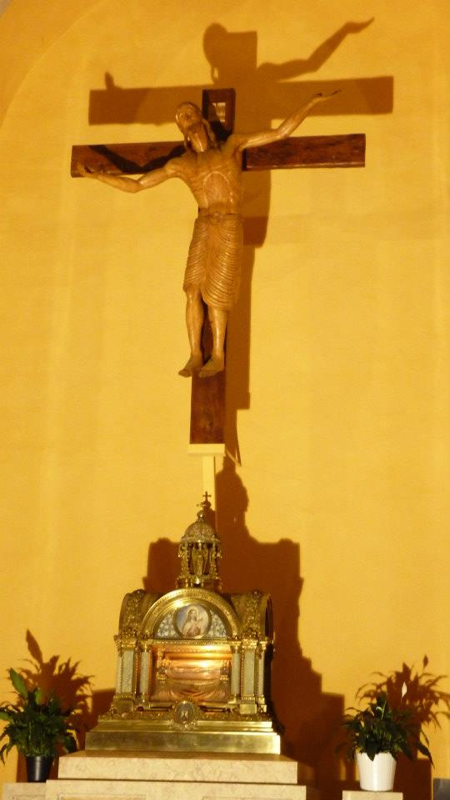
Reliquary of the right arm of St.Therese in the Basilica.
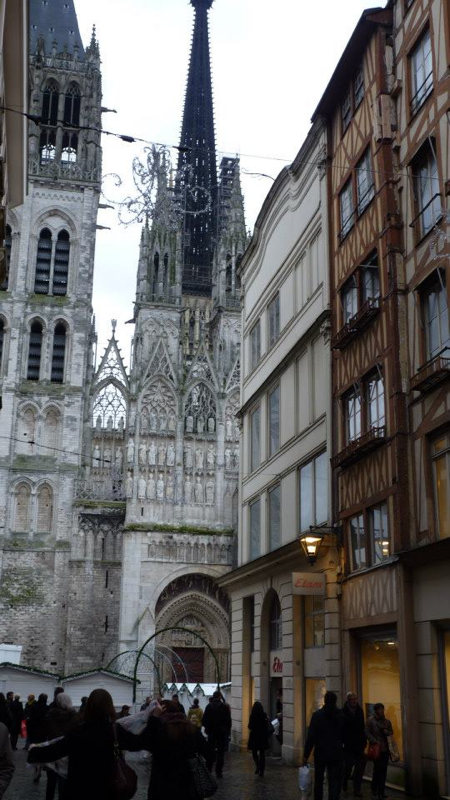
Rouen Cathedral
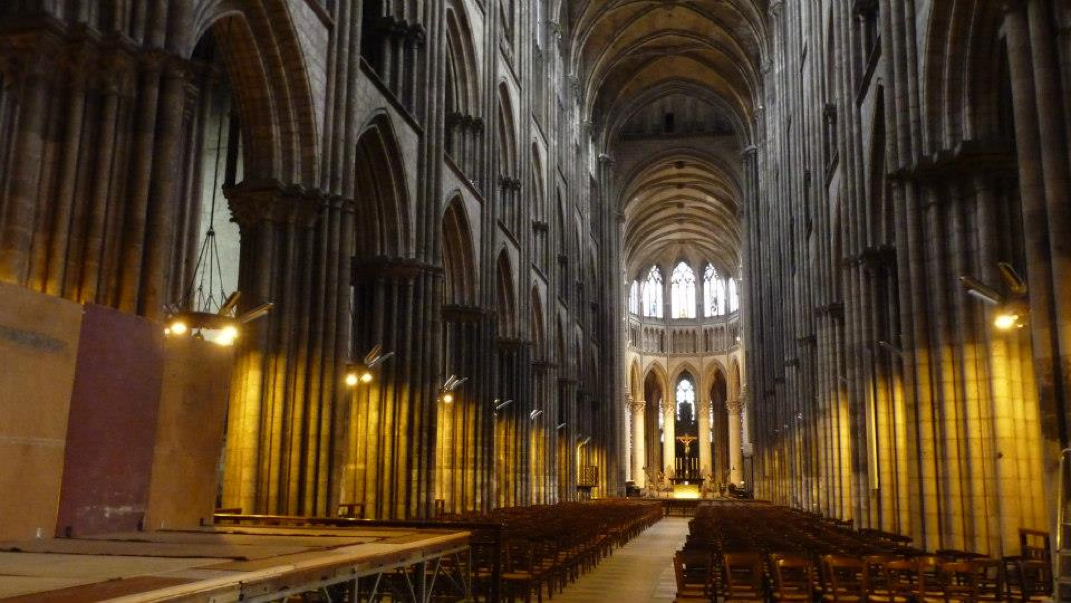
Rouen Cathderal
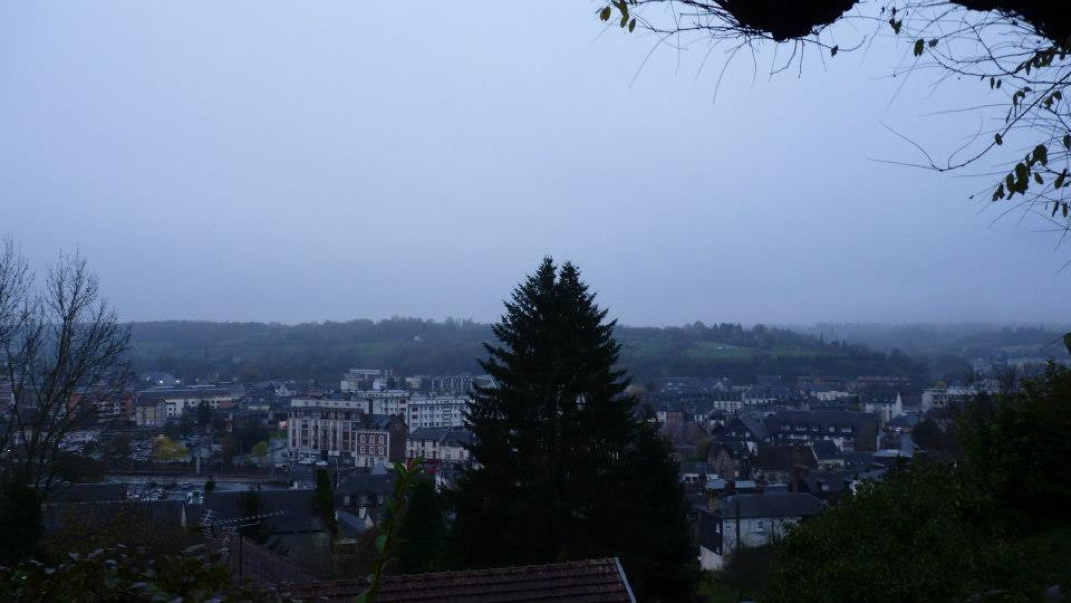
The town of Lisieux
My 8thweek (of a total of 14) in Paris brought several changes to the constitution of my residency. My wife, Grace, arrived on Sunday and gave me the opportunity to share my experiences in the city and the take the role of a tour guide. This condition allowed me to rethink my knowledge of the locus, as I made some return trips to churches and sites. This week also gave me the chance to go beyond Paris, to Normandy - Rouen and Lisieux, in particular.
A L'Aeroport CDG
My wife's arrival in France signaled the commencement of what I call my Second Itinerary: a review of Paris sites and churches with several trips outside the city limits in Île-de-France and even in places such as Normandie. While being solitary in Paris has led me to engage and test my core ideas of existence and aesthetic practice, conversations with my wife tested the excesses of solipsistic tendencies of my insights.
Return to Paris: Montmartre and the Latin Quarter, and up the Eiffel Tower
For the following three days I took my wife on an overview of the city, starting with a visit to Notre Dame and a walking tour of Montmartre (Sacre Coeur), the Latin Quarter and the Eiffel Tower. My wife, being a devout Catholic, shares a passion for old churches with me. For twenty years we have been exploring churches, temples and holy precincts in the Philippines and in other cities on Asia. Even as she sees the French churches and cathedrals as places to worship, I see them as structures of aesthetic significance. Churches were the target of our trips in her first week and this helped me to review details of architecture and sculpture in the cathedrals.
Ile de St-Louis, St. Merri, Notre Dame reprise
By re-exploring Paris on foot and on bus, I rekindled my impressions with churches of St-Sulpice, St-Germaine de Pres, St-Merri, St-Gervais St-Protais, St-Paul St-Louis, St-Severin, Chapel of the Miraculous Medal, St-Nicholas de Chardonnet and the Notre Dame de Paris. The reprisal of my research brought me to pay attention to details such as the stained glass windows, architectural details and style and even states of renovation and decay of the buildings. By now being familiar with the network of streets of central Paris, I am also able to appreciate and examine details of the urban landscape: apartments, houses and government buildings including former palaces.
Espace Comines
On Thursday I attended an exhibition opening at Espace Comines at rue Comines in the 3rd arrondissement. It was a group show of contemporary French artists which included Marjolaine Thiry, a sculptor whom Ive met through Marguerite during my first two weeks. Her work featured two large scale sculptures of plaster and paper mache of Sasquatch and a fat cat. The exhibit was quite interesting as it featured pieces of works made from materials that can be considered non-traditional, including strung and cut paper, bricolages of wood, drawings and zinc, large offset prints and an assemblage of odd parts of a chandelier.
Rouen
At daybreak on Friday we took the Intercités train from Paris St-Lazare to Rouen. This trip to Normandy fulfills a part of my residency plan to visit churches outside Paris, especially Cathedrals. Having deemed the trip way south a bit prohibitive (Burgundy etc), Ive decided to concentrate on cathedrals that are within an hour or so within Paris. I booked a hotel in Rouen for two nights. I planned to make this medieval city as my point of departure for Lisieux and/or Amiens in Picardie, although I decided to desist in going to the latter site because of logistics concerns. Because it was raining in Rouen, we limited our exploration of the city with documentation of the interior of the Notre Dame de Rouen and a brief visit to the modern Eglise de Ste-Jeanne d'Arc.
Lisieux
The following day, a Saturday, we took the first morning TER train to Lisieux in Lower Normandy. The theme of our trip was Ste-Thérèse, and we wanted to see the Basilica dedicated to her memory, as well as the other churches in the area that were connected with her life. We ascended the hill of the Basilica around 8am, still a bit dark despite the sunrise, and waited for the church to open at 9am. In the meantime we explored the church grounds and took photos of the town, which eerily reminded me of Paete or Liliw, in Laguna. After accessing the Basilica and the Crypt below it, we went to Carmel and paid our respects at the tomb of Ste-Thérèse. Then we went by the deconsecrated edifice of the church if St-Jacques, now used as an exhibition space and went to the Cathedral of St-Pierre, which was the church where Ste-Thérèse prayed to while a child and as a Carmelite nun. The Cathedral itself no longer hosts a bishop since the 1700's but its design- a mixture of Norman vernacular architecture with Gothic - is an interesting study on the dispersal of ecclesiastical styles in the high middle ages.
We returned to Rouen in the early afternoon and took advantage of the brief sunlight to take photos of Notre Dame de Rouen and the Gros Horloge (Big Clock) as well as the half-timbered houses of the town central. We were quite amazed to find droves of tourists and locals in the streets; the same areas where actually almost empty the day before.
Return to Paris: St. Etienne du Mont and Jardin de Luxembourg
We returned to Paris from Normandy on Sunday. The train ride was so unbelievably smooth and bereft of stress that we still had the strength to go on a walk to St. Etienne du Mont and the Jardin de Luxembourg in the afternoon and watch the sunset in the gardens. At St.Etienne we paid a visit to the relics of Ste-Genevieve and her sarcophagus and witnessed a baptism ceremony.
The trip to Normandy provided a much-needed respite from the urban life of Paris and allowed me to look at France from another angle. I discovered that I preferred the countryside than the city center when it came to churches
yet I still consider the museums in Paris to be more important than those in the regions. This week's experience with the ease of train travel has also led me to consider more trips outside Paris, within the means of my funds and the limits of my remaining time in the residency.
My eigthth week (of a total of 14) in Paris brought several changes to the constitution of my residency. My wife, Grace, arrived on Sunday and gave me the opportunity to share my experiences in the city and the take the role of a tour guide. This condition allowed me to rethink my knowledge of the locus, as I made some return trips to churches and sites. This week also gave me the chance to go beyond Paris, to Normandy - Rouen and Lisieux, in particular.
A L'Aeroport CDG
My wife's arrival in France signaled the commencement of what I call my Second Itinerary: a review of Paris sites and churches with several trips outside the city limits in Île-de-France and even in places such as Normandie. While being solitary in Paris has led me to engage and test my core ideas of existence and aesthetic practice, conversations with my wife tested the excesses of solipsistic tendencies of my insights.
Return to Paris: Montmartre and the Latin Quarter, and up the Eiffel Tower
For the following three days I took my wife on an overview of the city, starting with a visit to Notre Dame and a walking tour of Montmartre (Sacre Coeur), the Latin Quarter and the Eiffel Tower. My wife, being a devout Catholic, shares a passion for old churches with me. For twenty years we have been exploring churches, temples and holy precincts in the Philippines and in other cities on Asia. Even as she sees the French churches and cathedrals as places to worship, I see them as structures of aesthetic significance. Churches were the target of our trips in her first week and this helped me to review details of architecture and sculpture in the cathedrals.
Ile de St-Louis, St. Merri, Notre Dame reprise
By re-exploring Paris on foot and on bus, I rekindled my impressions with churches of St-Sulpice, St-Germaine de Pres, St-Merri, St-Gervais St-Protais, St-Paul St-Louis, St-Severin, Chapel of the Miraculous Medal, St-Nicholas de Chardonnet and the Notre Dame de Paris. The reprisal of my research brought me to pay attention to details such as the stained glass windows, architectural details and style and even states of renovation and decay of the buildings. By now being familiar with the network of streets of central Paris, I am also able to appreciate and examine details of the urban landscape: apartments, houses and government buildings including former palaces.
Espace Comines
On Thursday I attended an exhibition opening at Espace Comines at rue Comines in the 3rd arrondissement. It was a group show of contemporary French artists which included Marjolaine Thiry, a sculptor whom Ive met through Marguerite during my first two weeks. Her work featured two large scale sculptures of plaster and paper mache of Sasquatch and a fat cat. The exhibit was quite interesting as it featured pieces of works made from materials that can be considered non-traditional, including strung and cut paper, bricolages of wood, drawings and zinc, large offset prints and an assemblage of odd parts of a chandelier.
Rouen
At daybreak on Friday we took the Intercités train from Paris St-Lazare to Rouen. This trip to Normandy fulfills a part of my residency plan to visit churches outside Paris, especially Cathedrals. Having deemed the trip way south a bit prohibitive (Burgundy etc), Ive decided to concentrate on cathedrals that are within an hour or so within Paris. I booked a hotel in Rouen for two nights. I planned to make this medieval city as my point of departure for Lisieux and/or Amiens in Picardie, although I decided to desist in going to the latter site because of logistics concerns. Because it was raining in Rouen, we limited our exploration of the city with documentation of the interior of the Notre Dame de Rouen and a brief visit to the modern Eglise de Ste-Jeanne d'Arc.
Lisieux
The following day, a Saturday, we took the first morning TER train to Lisieux in Lower Normandy. The theme of our trip was Ste-Thérèse, and we wanted to see the Basilica dedicated to her memory, as well as the other churches in the area that were connected with her life. We ascended the hill of the Basilica around 8am, still a bit dark despite the sunrise, and waited for the church to open at 9am. In the meantime we explored the church grounds and took photos of the town, which eerily reminded me of Paete or Liliw, in Laguna. After accessing the Basilica and the Crypt below it, we went to Carmel and paid our respects at the tomb of Ste-Thérèse. Then we went by the deconsecrated edifice of the church if St-Jacques, now used as an exhibition space and went to the Cathedral of St-Pierre, which was the church where Ste-Thérèse prayed to while a child and as a Carmelite nun. The Cathedral itself no longer hosts a bishop since the 1700's but its design- a mixture of Norman vernacular architecture with Gothic - is an interesting study on the dispersal of ecclesiastical styles in the high middle ages.
We returned to Rouen in the early afternoon and took advantage of the brief sunlight to take photos of Notre Dame de Rouen and the Gros Horloge (Big Clock) as well as the half-timbered houses of the town central. We were quite amazed to find droves of tourists and locals in the streets; the same areas where actually almost empty the day before.
Return to Paris: St. Etienne du Mont and Jardin de Luxembourg
We returned to Paris from Normandy on Sunday. The train ride was so unbelievably smooth and bereft of stress that we still had the strength to go on a walk to St. Etienne du Mont and the Jardin de Luxembourg in the afternoon and watch the sunset in the gardens. At St.Etienne we paid a visit to the relics of Ste-Genevieve and her sarcophagus and witnessed a baptism ceremony.
The trip to Normandy provided a much-needed respite from the urban life of Paris and allowed me to look at France from another angle. I discovered that I preferred the countryside than the city center when it came to churches
yet I still consider the museums in Paris to be more important than those in the regions. This week's experience with the ease of train travel has also led me to consider more trips outside Paris, within the means of my funds and the limits of my remaining time in the residency.
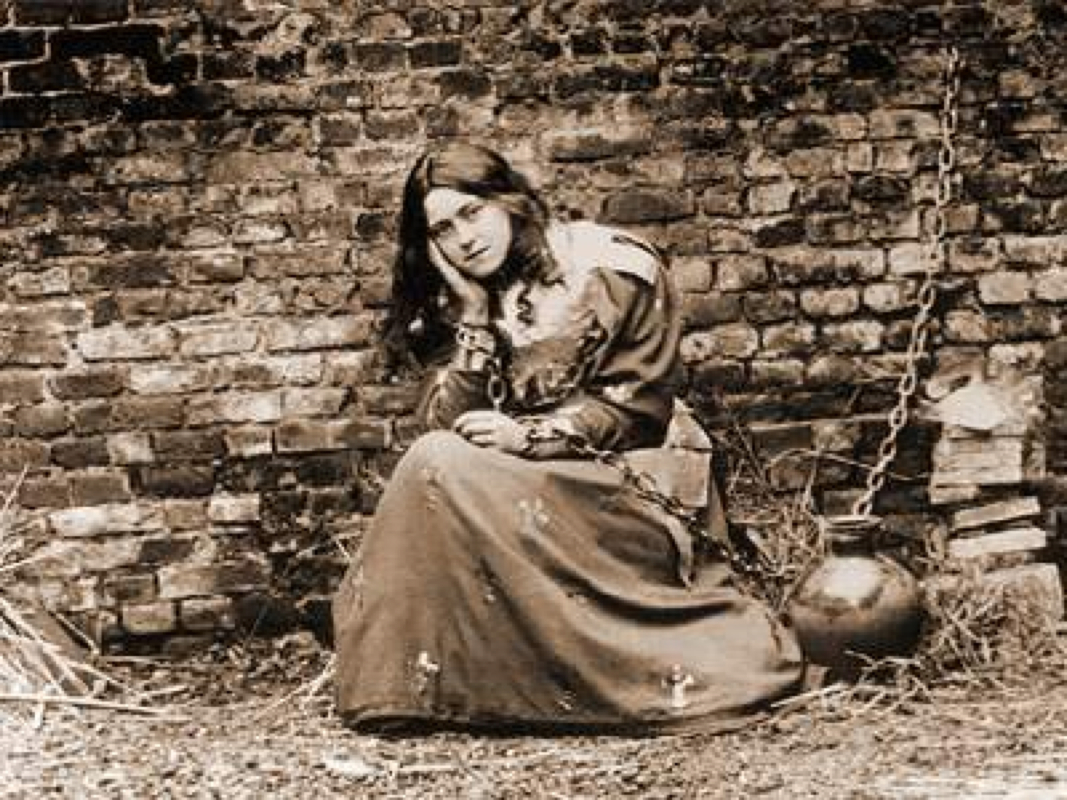
St Therese dressed as Joan of Arc.
Today I fulfilled a promise, a panata in Filipino, to visit St. Therese in her hometown in Lisieux in Lower Normandy. A panata is a unilaterally forged agreement with a religious personage, made by the supplicant as "payment" for divine favor that is granted. This transaction between deed and divine intervention is not so far from the mind of the Medieval French, who, under feudalism built the cathedrals that I have been eagerly frequenting. This was the running commentary in my head as my wife and I took the TER train from Rouen Rive Droite to Lisieux, at daybreak at 7am.
The train window frames the scenic view of Normandy's fields and towns coming to light from the darkness of the dewy morning, and I think of St. Therese and her book, Autobiography of a Soul, which I have read when I was a teenager. This saint who lived in modern times within the confines of a cloister of the Carmelite order, died at the age of 24. In photographs she is perpetually young, even as her words speak of a mind that is even more tender - and to my reading she sounds more like an adolescent gushing about her first love than a nun speaking of a way of religious life. Thus, this way I was enamored and it also helped that the church in Los Baños where I spent some Sundays during highschool weekends was dedicated to her. The parish priest then tried to wrestle me from bouts with atheism, and demonstrated a great store of knowledge about Buddhist meditation as a response to my comment that I have never met or heard a priest who wasn't a stupid bore. Pity I have never remembered his name, for he was the recipient of my very last confession as a Catholic.
But even as I removed myself from the liturgical and sacramental aspects of the religion of my baptism, I still retained my curiosity about the lives of the saints, with St. Therese as an exception. She was, in fact, the only saint whose words I could read (her book still remains with me, in e-book form in my Ipad) while I found the meditations and memoirs of St. Augustine, St. Teresa de Avila, St. John of God and St. Ignatius a bit obtuse and verbose. I recalled a teacher telling me that he found it surprising that I as young man would purchase Thomas a Kempis' Imitation of Christ and the Cloud of Unknowing - both treasures of the Medieval Catholic tradition. He laughed when I told him that I have even read St. Jose Maria Escriva, whose rightist conservatism appealed to me the very same time I plunged through Camus' The Stranger. He called my mind in a state of "philosophical discotheque" which I admit to be true, even to this day.
We arrived at the Lisieux train station just as the morning was unfolding at 8:07 am. From the platform we could see in half-light, the grandiose Basilique de Sainte-Thérèse standing on a hill. Aided by a hand-drawn map I made the night before, we climbed the ascending road to the church, chilled as we were from the frozen air. When we made it to the eponymous avenue that leads up to the plateau where the building rests, I scanned the hilly horizon of Lisieux and I cannot but help compare the landscape to Paete, or Liliw in Laguna with the cold wet atmosphere of Tagaytay or Benguet. It was a Saturday morning: nobody was in sight save for a utility man who drove a petrol-powered, foul-smelling, smoke belching motorcycle-drawn cart and collected the trash from the bins around the basilica grounds. The church would not be open until 9 am so we ventured to explore the areas behind it, and found the alcoves of the Stations of the Cross and the empty tombs of St Therese's parents, the Blessed couple Zellie and Henri Martin.
Fighting and cawing crows on the basilica dome punctuated the morning stillness of Lisieux. I asked my wife if she felt overwhelmed by places like these, because there are moments when I still am in disbelief when beauty saturates my senses. There is even a pang of insecurity that pervades my mind, and I reflect (almost spontaneously) if I was worthy to be in the presence of churches such as these. Or even landscapes that unfolded to us on our journey. I wonder if this is the culturally-induced meekness and insecurity complex that is the result of being from a poor and former colonized country. It is not on a few occasions that I have to reassure myself that there is nothing to be ashamed of, and that I am equally worthy to impose my sight and incorporate beautiful and sublime sites in the empire of my eyes.
The thought that bothers me often is the notion that I am walking in the land of the gods and overlords. So it was with some sort of vernacular comfort to see the work of Manuel Baldemor on the internal western wall of the Basilica. Mr. Baldemor was quick to provide the clue that his work is Filipino: the design corresponds to the tricolor and the sun of the flag. Looking at it while glancing at the neo-Byzantine design and mosaics nearby, made me think of an analogy of someone hollering balut! along Champs-Elysée. Pinoys would recognize and respond accordingly.
I stare at the oversized dimensions of the church. A brochure said that the architects thought of Sacre Coeur when they designed the building. This might be true for the exterior but inside the lack of obstructive columns reminds me of Hagia Sophia in Istanbul, where a dome surmounts a cubic form and leaves a central space vastly open. This, I thought, is an exaggeration of the spirit of St. Therese, the advocate of the Little Way. In this logic I cannot understand why the basilica is so huge...and so out of sync with the vision, ideas and words of this young Carmelite nun. Why neo-Byzantine? Why Sacre-Coeur in inspiration? St Therese herself prayed in a Norman Gothic cathedral, so why the reinvention of her vision? The only space I saw fitting to the spirit of the saint was the Crypt, which now holds the remains of her parents, a couple so exemplary they are on their own way to sainthood, being declared Blessed (the same rank of John Paul II who approved of their elevation).
So to ease my mind of all the discomforts of scale, my wife and I went to the Carmel convent where the saint spent her religious life with her four other sisters. On the way out of the Basilica and on the way into the Carmel church we noticed some burly men begging with plastic cups in their hands. My wife and I both remarked "ang lalaking tao hindi magtrabaho!" Perhaps we should be thankful that in Lisieux these men from Eastern Europe politely beg, when their counterparts in Paris do all sorts of scams and hustling, also in the name of charity.
At the Carmel, we stayed at the Tomb of Ste-Thérèse, staring at her marble sepulcher created in the likeness of her body when she laid in state after dying from tuberculosis. I told my wife that I did not agree with her expression of happiness when she learned that she was dying. It was years ago when I threw that yoke of the idea of life as a pilgrimage, that conscious, corporal existence is but a way station to the afterlife. I rebel at the idea that Therese and other saints take existence like it was some curse that one cannot wait to die and go to heaven. If God did create the universe and is the giver of life, why show him disrespect by ignoring creation and repressing life? Of course the answer lies in the socio-political dimension of Catholic religion as an effective proponent of feudal lifeworlds. The Church saw this fault itself and thus gave birth to the radical modernization of Vatican II in the mid-20th century. (Oh brother, I remember having read the documents of Vatican II as well! So as not to say I didn't give my old religion a fighting chance.)
My thoughts regarding my former faith is exemplified in the condemned building that is the beautiful Gothic Eglise de St-Jacques near the Lisieux Rotonde. Left unused since the1960s it is nevertheless a functional art exhibition space. This church stands as an edifice, but no longer functions as a religious front but as an aesthetic sanctuary. If there is a symbol of what I am attempting to do with my rebulto-work, St-Jacques is it. I am reclaiming the craft and techniques of rebulto-making in the name and domain of artistic practice.
Our last stop in Lisieux and on the heels of St Therese is the Cathdrale St-Pierre, where the saint's father donated a high altar. Although a cathedral, the church no longer hosts a bishop's seat since Napoleonic times. But its architecture remains a beautiful example of vernacular Norman architecture (the use of rectangular walls and a pyramidal roof) meeting with the Gothic (Latin cross design, tall columns, pointed arch, ribbed vaults and flying buttresses). The church also as several features connected with the Martin family and St Therese. It contains the chapel the Martin patriarch rents every sunday mass, the end-chapel where the Carmelite saint prayed for the conversion of a condemned murderer, and a confessional where she frequents both as a young girl and as a nun.
We were lucky enough to walk briskly enough to catch the first afternoon train back to Rouen, the rain having us running almost to the station. While waiting for the TER coaches to stop at the station I took one last gaze at the gigantic basilica of a little saint. My panata is fulfilled and in vernacular faith, this means a chance for another request. But I cannot utter one now. The church on the hill, like a white crown above the green, seemed to look back at me. And in a childish fashion (which seemed odd) I said goodbye for now and see you again - and waved.
St. Therese was a cute saint, after all. Wasn't she a pretty inspiration for an adolescent mind? Or wasn't she a playmate of my young intellect? She is the only saint that I consider human. All-too-human. And that makes her relevant.
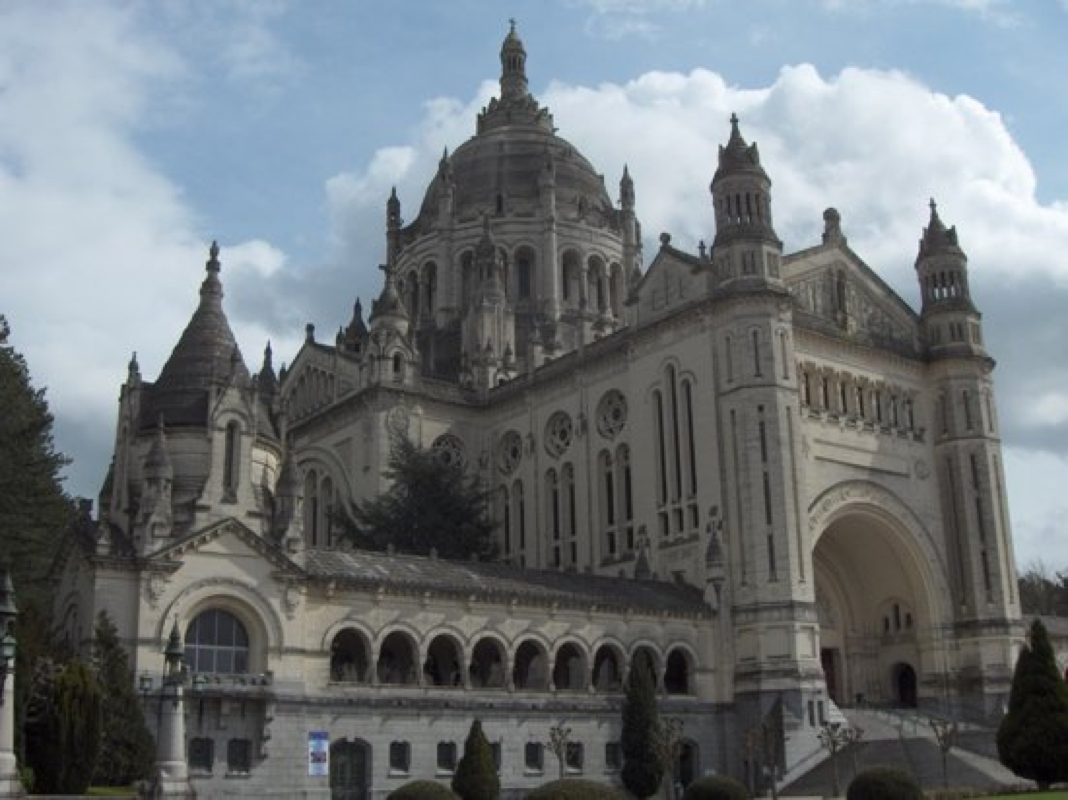
Basilique de Ste-Thérèse, Lisieux
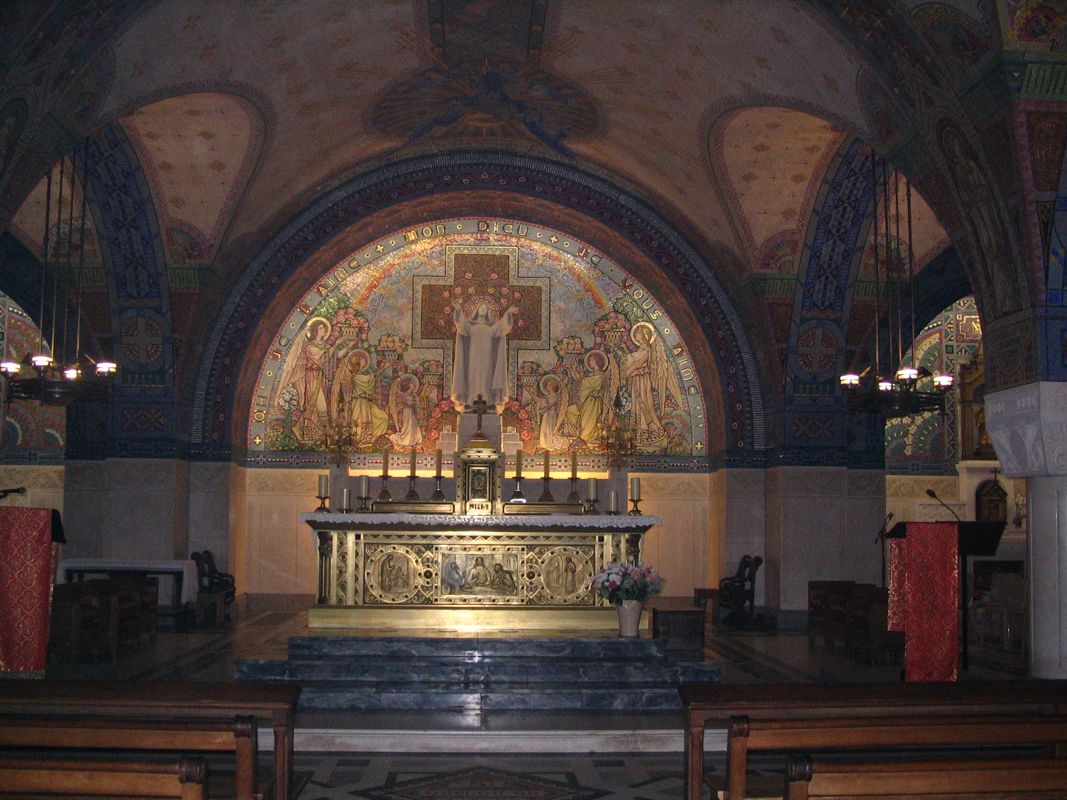
The Crypt.
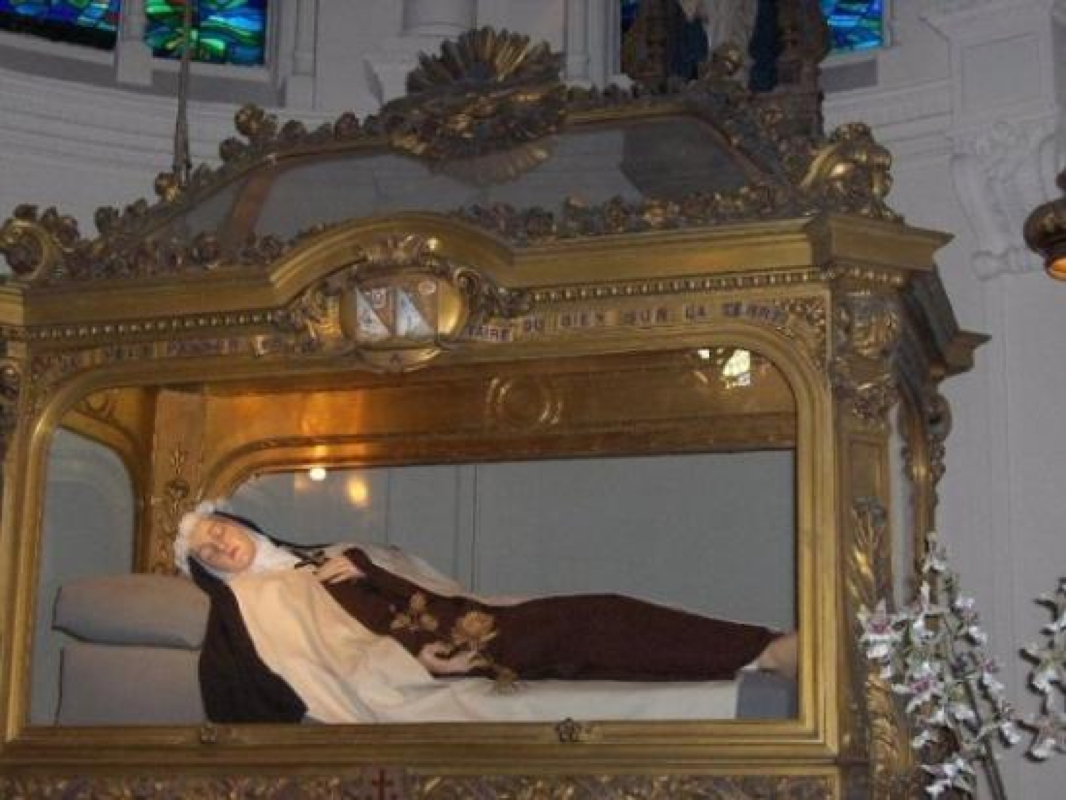
The effigy of Therese in Carmel, Lisieux
I am in Rouen, in Upper Normandy to gaze at the Notre Dame de Rouen. This cathedral is one of several named Notre Dames built around the same period in the 12th century. The Cathedral was made famous at one time because Claude Monet painted canvases using its facade as subject, in various seasons and times of the day. (Monet is in fact honored in the local museum as well as within the city). This Notre Dame is also an example of High Gothic architecture but with several additions of Renaissance and Baroque. The rains made it difficult for me to get a decent shot of the famous exterior and its interior does not have the same radiance as the rose windows of Notre Dame de Paris. I am waiting for a clearer sky tomorrow.
Back in Paris I often thought of its Notre Dame as a metaphor of my experiences here. Like its structure that was built over several decades, my sojourn is also likewise constructed by different layers of episodes and days. Some days are insightful and some are really dull and even bad.
Yet a person's existence can be compared to a cathedral. The core of the person is a complex cluster of memories of experiences that are held to be holy and sacred, and even inviolable. These memories are locked into small tokens, sacramentals which can activate the ideas within by means of ritual. The collection of these objects form the sacred space of the individual. This is kept in the holy of holies, in a vault, in a crypt, far from the prying eyes of the uninitiated. Through time the exterior of the person is built around these complexes, and the structure is made of temporal unities, not spatial elements. But in a cathedral, the stones are erected to greater heights. Thus a person is constructed.
But like Rouen this cathedral can be struck down by lightning and by bombs and by assaults of the revolution: the structure can fall. It can also crumble and fade, and be dissolved by acid rain. The person is the construct: it is the consciousness of being that lies beyond destruction. But this experience - the spoke of all wheels of epiphanies and experiences - is cultivated, not given. Sometimes this center of experience-less being is the reason why I work. It can only be uncovered, and discovered by total immersion in a path. And my path is artistic creation, my passage is the connection to the freedom of that child, that magical innocence sans the guilt of sin and the fear of censorship. If that center is there, then a cathedral can be rebuilt, several times over and even improved little by little, again and again. Only to be subjected to another round of destruction.
And so I now understand why I am keen on seeing these Notre Dames, these basiliques, these eglises. My life is seeking its proper metaphor.
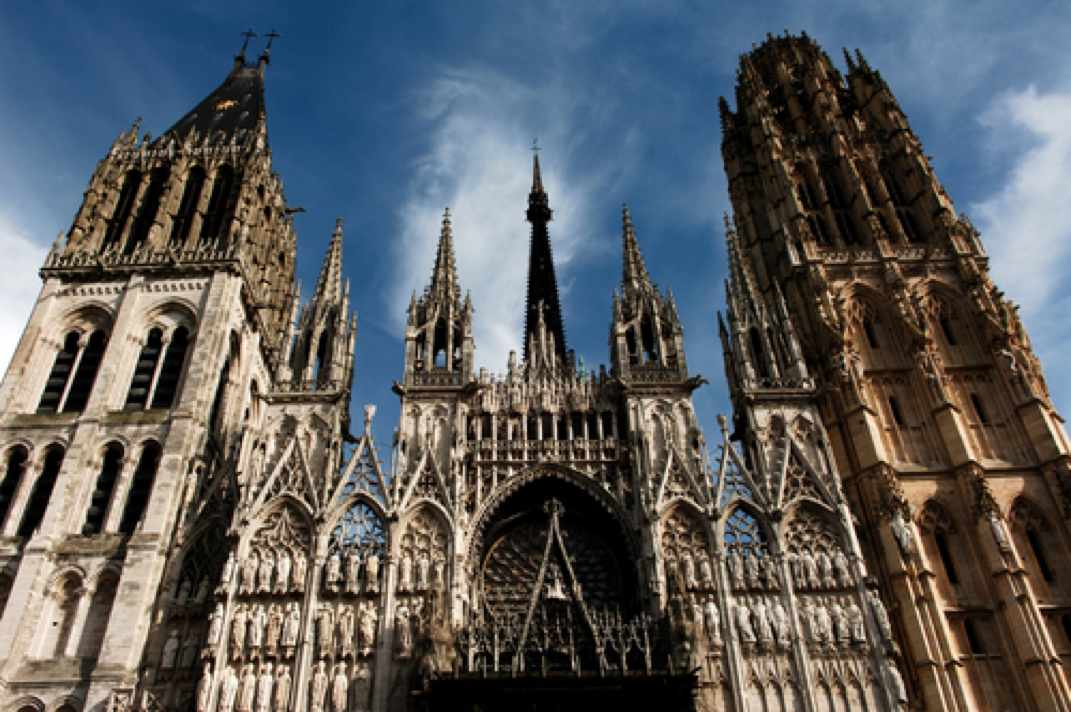
Notre Dame de Rouen
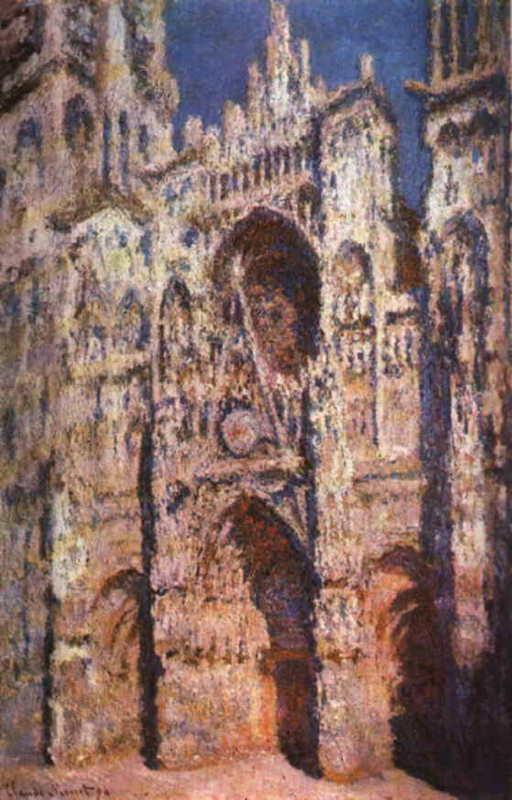
Rouen cathedral by Claude Monet.
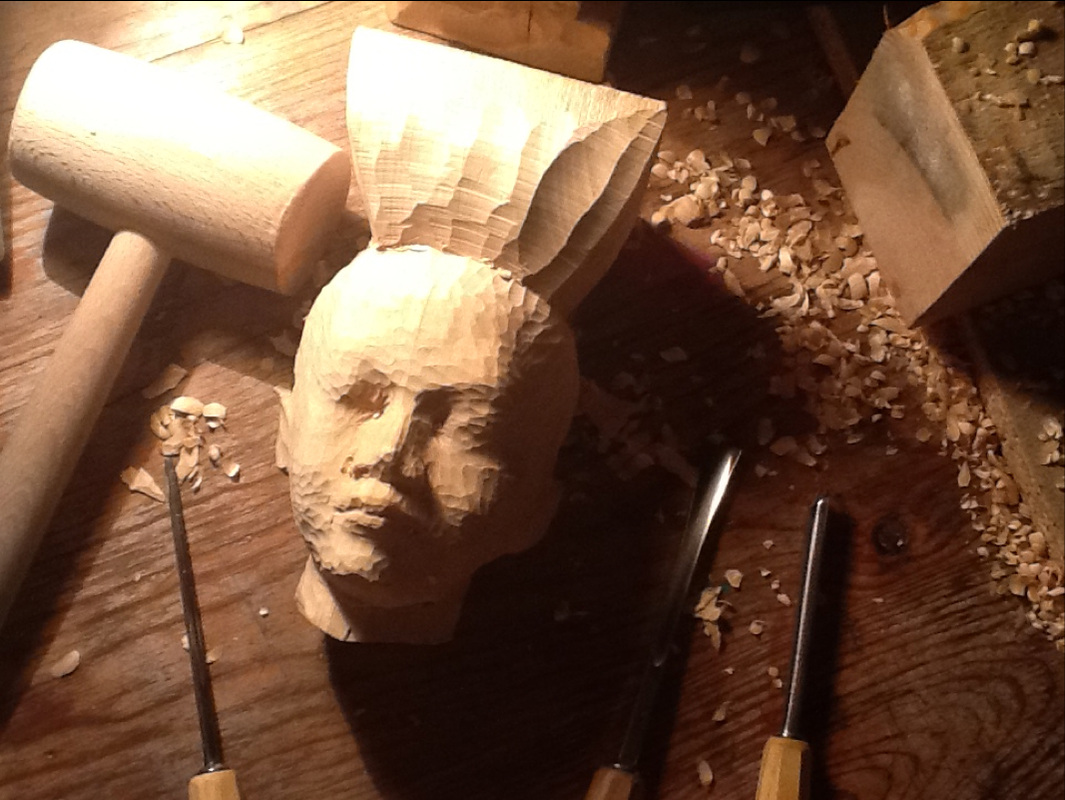
Head of the Sto Niño...
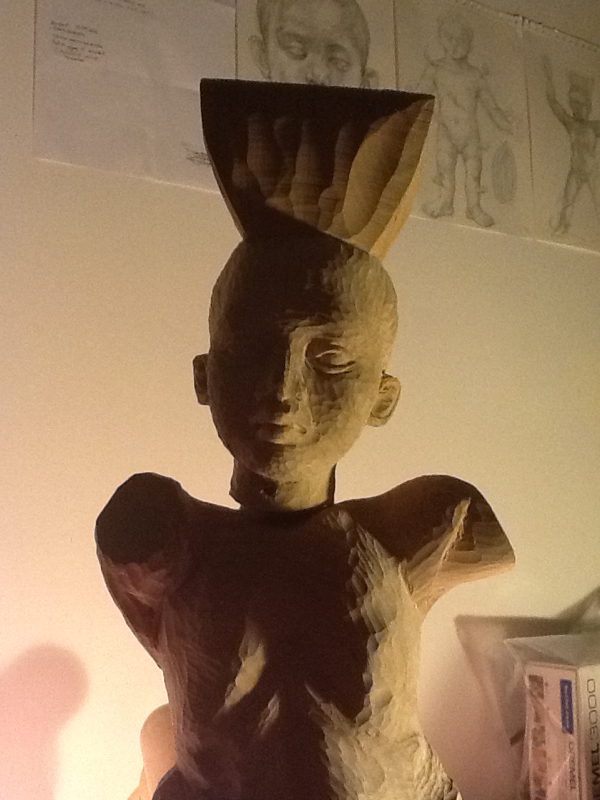
The santo progresses...
My wife, Grace, arrived in Paris last Sunday; she will join me in my residency at Cite de Arts until next month. I had hoped to give her an overview of the city this week but the itinerary I drew up was unrealistically compact and she advised me (asthma attacks considered) that I needed to slow down and stop rushing, especially her. For more than 40 days I did in fact, undertake my research at a frantic pace, and now that I am working on some sculptures, I forgot to step on the brakes and change to a lower gear. Note to self: decrescendo.
Yesterday we were at Sacre Coeur and St.Pierre at Montmartre. This is the fourth time Ive ascended the Butte Montmartre and gawked at Sacre Coeur. Besides the usual tourists (plus the hawkers and hustlers that hover constantly among them), the place was unusually full of artists. With a pad of papers clipped on drawing boards and a set of pastels they take posts at certain street corners and ask (politely) passersby if they wanted their portraits done. Some make caricatures. The open tree-lined space in front of the abbey church of St. Pierre is an outdoor gallery of paintings, prints and drawings, mostly of Parisian scenes on small canvases, boards and paper. The latter, like finished portraits, are rolled and placed in a tube after payment has been made. The painted landscapes, although good, remind me of the Mabini paintings in Manila and for good reason: these are of course commercial art. (Instead of the Manila sunsets, the subjects are the Eiffel Tower, or the Arc de Triomphe or even Sacre Coeur.) This scene is of course a continuation of a history of artists making their living in Montmartre, as attested by the numerous artists who lived here in the early 20th century: Picasso, Utrillo, Dali etc.
Seeing these I recall the story of how Modigliani, the Japanese painter Foujita, and their clique went to Nice on a disastrous journey to sell their paintings to rich tourists. They managed poorly and were driven back to Paris by sheer lack of funds. Van Gogh was also asked by dealers to concentrate on painting landscapes for the same clientele, which the artist did not heed and strove to work beyond the demand. Yet most of the time this type of commerce is considered detrimental to art as a practice. My take here is simple: art goes beyond creative work and into various forms of exchange, or commerce. Now, there is a broad range of markets that deal and cater to different art forms and objects and the artist must be clear where he wants to engage in. Having seen the high profile art fair FIAC last month and the quirky Slick Paris, considering other various exhibits in the city, I have discovered that Paris possesses this broad range of markets and is offered to equally varied audiences. Art is valued in two main markets: the market of the art object and the market of aesthetic ideas.
Today we took on the Eiffel Tower and ascended to its summit. From the topmost platform I took pictures of the city and marveled at the grand scheme and organization of Paris. It was just too cold for us to stay long outside and we simply took the second floor viewing area instead. Nevertheless, with an overview of Paris literally around us I was able to discern the various areas and sites that I have been to and was satisfied with the knowledge that I had explored a large part of it already. Oftentimes this perspective is essential in understanding how much one actually knows and how much more can be known. This weekend I will be going north to Normandy to visit Rouen and Lisieux. Perhaps with this trip I can extend my horizon of knowledge a little bit further. Everything here seems just that - a furthering of horizons.
I devoted this week exclusively for working and research on sculpture in conjunction with the work that I am finishing for St. Merry. The wood sculpture is progressing quite rapidly and a midweek visit to Musée Rodin had given me a number of ideas and insights that I can apply to my own work. Having been in Paris midway into my residency I have also noticed some changes in my behavior and routine that reveals a certain level of grounded-ness on my part.
A tour (and attending part of the mass) of the abbey church of St.Pierre de Montmartre was the starting activity of the week, Sunday. This time I decided to take the bus (Line 96) to get to Pigalle and from the ascend the Butte Montmartre on foot. It has become a weekly habit for me to visit this area at least once a week to take in the panorama of the city and also to make sketches of people, places and scenes. The following day I took more tools to St. Merry to continue carving and this activity continued until the next day. With keys given to me by Marguerite I had access to the cellar and have on occasion worked for six to seven hours until evening. But at the end of Tuesday night I felt I needed some references in technique. I was working with my own blocking technique and wanted to know what other sculptors here used to make forms.
To this end I spent half a day's worth of hours in Musée Rodin in rue de Varenne. (For a more exhaustive account of this visit see my blog at riel.weebly.com) From this visit I was able to gather a number of insights into sculpture as a craft. Rodin's own body of work had developed from the tradition of figurative statuary, referencing the Greco-Roman examples of Antiquity. His works form a stylistic bridge between this tradition (carried on by Renaissance ateliers to Neoclassical academies) to the modern epoch with an increasing sense of consciousness of material and process. To be honest I have tarried in seeing this museum because my subject of research, medieval sculpture, was seen by artists like Rodin as a backwater of a linear view of art history. Rodin directly connects with the epoch after it, via Michelangelo and the one preceding it. Medieval statuary was influenced not by naturalistic observations but by systems of proportion of a mystico-mathematical geometry. And of course majority of medieval sculpture are engaged with architecture, as ornaments. Rodin, like the Renaissance, Baroque and Romantic artists that worked before him had freed sculpture as an independent work, although the highlight of the oeuvre of a master's career was still, the monument.
Rodin was always said to be a genius modeller. Which means his clay models almost always held the vigor that was essentially captured in bronze, or in marble, by many collaborators. I was amused to discover that this artist had employed several apprentices, casters and stone cutters that some have actually complained that Rodin always kept claiming all labors to his credit alone. A sly contemporary even took note that before the cameras and reporters came in to his numerous ateliers Rodin would have asked the workers to exit and place bits of marble on his beard to look as if he was in the middle of work! Rodin had improved his craft so much he made it into a career and later as an enterprise. (And engaging the services of writers such as poet Rainer Maria Rilke and Kahlil Gibran!) He milked the romantic idea that all sculptors worked alone, like Pygmalion, and became wealthy. Not bad!
My attention was held for a few hours at the special exhibit of his marble works titled, Flesh and Marble. It was a wonderfully curated show that featured Rodin's use of the non finito (unfinished) technique in carved stone which he was successful in employing in his bronzes and plasters. Although none of the 400 works of marble can be claimed to be worked on by him directly (he employed stonemasons) the result of the non finito technique was amazing in translation to stone. The exhibit so moved me that I began thinking of working in carving marble as well. (But when I saw a video of how marble was carved by hand, I realized I needed to build a new studio for this). I had several insights into the main characteristics of Rodin's work and learned some secrets behind their sense of power, besides monumentality. I promised myself to find a way to translate these in my own work as well.
This I attempted to do in the remaining days of the week with my sculpture project in St. Merry. I realized that the nearest technique that comes close to Rodin's carving process (or his stonemasons) is the gouge-work employed in Paete, Laguna in the Philippines. The carvings of indigenous peoples of the North employ more flat chisel (paet) techniques that result in more linear finish. Paete carvers utilize a wide range of gouges that is used to cut rounder pieces, in a Baroque fashion and style. But there is a whole universe between stone and wood carving! Stone uses punches to break the stone and then it is worked with rasps and files to achieve polish. Wood is technically cut and shaved (chipped). I was also able to observe an ivory carver near St. Germain de Pres and I was fascinated that he uses more rasps and files to create the shape he wants. Surely the subtractive method of sculpture is a world on its own.
With the conclusion of this week I begin my final 40 days in France. After the sculpture is finished I am off once more to a research mode. Next week I will be exploring regions outside Paris, from Ile de France to Normandy, Picardie and Champagne.
If I could sit by the heater all day I would; it is getting colder. As a man who enjoys the sun the incoming winter of Paris is already giving me a slight discomfort. But I think of the homeless downstairs in the open air. Hell, if they can do this I also can!
Last night while crossing rue de Renard from St. Merry I took a glance at the silhouette of Norte Dame and thought nothing of her but just one of the buildings in the background. Indeed my daily route has taken on the semblance of a routine that I no longer pay attention that much to the city which, in the past weeks have been so interesting I wanted to be outside as much as possible. Perhaps being involved in a project does this to consciousness where focus is only on tasks and circumstances, relegating all else into a neutral level of awareness. Or this: Paris has taken hold of me, the city has engulfed me. I no longer see it from the perspective of an outsider and more frequently, from a vantage point of a denizen.
Despite the creeping sense of blasé, I value this experience because it is an integral part of a residency that goes beyond a month. Often the first week is nothing but an intense exploration (fueled by an imperial curiosity) guided by a list of Things to See or Things to Do. When this monster has been sated within and a more equanimous sense of reality (indeed reality) has the driving seat once more, the pace of one's life settles into an easy, spontaneous and slightly pragmatic existence. Its a difference between walking a road while intoxicated (everything is either a haze or a kaleidoscope world) and when sober. Yes I think that is the proper word: sober, le mot juste.
The keys to a sober mind in a foreign country (and I am thinking of future grantees and my next residencies) is simple, really.
First, know what your needs and look for the facilities that addresses them. Having a local to guide you around in the first week is very vital. Or else learn how to read a map and have access to the internet for starter tips on how to's etc. Foremost on the list (you can use Abraham Maslow's hierarchy of needs as reference) is food, comfortable shelter, proper clothing. I had to know where to buy food (nearest groceries and their hours and days of operation), how to arrange my atelier to maximize my space (moving furniture and buying supplies like soap, clothes hangers etc - which means know where to buy them at the nearest department stores) and finally what sort of clothes you need to wear in public. What to wear is a matter of adjusting to what you brought with you in your luggage and observing others.
Second, learn the basic skills you need to communicate and be mobile. This means to take cognition of people you essentially need to communicate with (receptionist in the lobby, your family, local guide) and the means to speak to them (useful phrases, mobile phone, internet access). I say essential people because acquaintances will naturally pop up as the days go by: you dont need to chummy up to anyone although it pays to be polite and courteous. Word of advice: curb your compassion for the needy in the streets. Give to street performers who really entertained you but keep off those who say they are seeking help for the poor and the children of wherever. Chances are great they are hustlers and pickpockets. (In Paris where I stand out as an obvious tourist Romanians descend upon me with petitions and papers and use English to cajole me out of my inertness. My advice- do not talk and shoo them away with conviction.)
How to get to a destination especially if your contact is in another area is so important, you need to know the means of transportation. I used to walk to and from the Louvre and it takes me 25 minutes. Take the Metro takes only five, but decidedly less to see. Now buses are my main mode of ambulation. They are often less crowded too.
Third and last, have an itinerary that keeps in mind the number of your days of stay and the pace that you want to have. Paris for instance can be bewildering, oh believe me. There's always an attraction in every corner, and all those pictures, movies and books that make mention of this city will all make you want to "go and see" at every opportunity. I have learned that the best way to know Paris is to disregard what you have read or learned from representations of the city back home. Again, know your objectives and prioritize - the Eiffel tower will not move an inch even if you do not see it on your first day. Its the events (like exhibits) that will go away if you do not mind your schedule. Museums with permanent collections, like the Louvre and the Musée d'Orsay will not disappear anytime soon as well. You can visit these on more relaxed and leisurely days: the best days to see art.
My residency here is structured but open. It means that while I have target sites to visit (churches and museums) I am able to see them at my discretion. Of my 81 days of being here I made it a point to do my research in the first 40 days so I can be more creative with a project and with extended trips to Ile de France and other provinces in my last 40. To date of my all the museums I needed to see, I only need two more, but on a more leisurely round. I even returned to my main museums twice or even thrice. Of all the churches, I only need to see five more and they are all outside Paris so after my project is up I can go there without pressure and book a hotel for two, three nights. (Will be staying in Rouen next weekend as a base to see Lisieux, Bayeux in Normandy and Amiens in Picardie).
If Paris is a sumptuous buffet, then the proper way of making the most of this is to take small samples (tikim) of what you find interesting and indulge (by way of second helpings) with the ones that made an impression. I used to think sketching from public art would be a great idea; its not. Three reasons: unpredictable changes of weather, unpredictable ebb of one's energy and stamina and the very predictable hovering and hounding of hustlers, petty thieves and other unsavory characters preying on tourists (they hang around Notre Dame, Trocadero, Montmartre, Jardin de Tuillerie). Trust intuition and common sense in doing this.
I am often reminded of Paolo Coehlo's tale in The Alchemist of a man who sought the principle of happiness from a wise king. The king had given the man a spoonful of oil and asked him to go around his palace. In his first round the man was so conscious of not spilling the oil in the spoon that he failed to see the palace. Chided by the king of his ignorance of the beauty of his domain, the man went out the second time to appreciate the beautiful castle but in so doing, forgot to keep his spoonful of oil in mind and spilled its contents. The king then said, "Happiness consists in that balance of enjoying the pleasures of life without spilling one's spoonful of oil." Like the Delphic oracle that says "Nothing to excess", means to know excess and austerity and then to find its middle path.
I often find myself in Paris like a spoonful of mind wandering about its 20 districts, careful not to trip and be spilled.
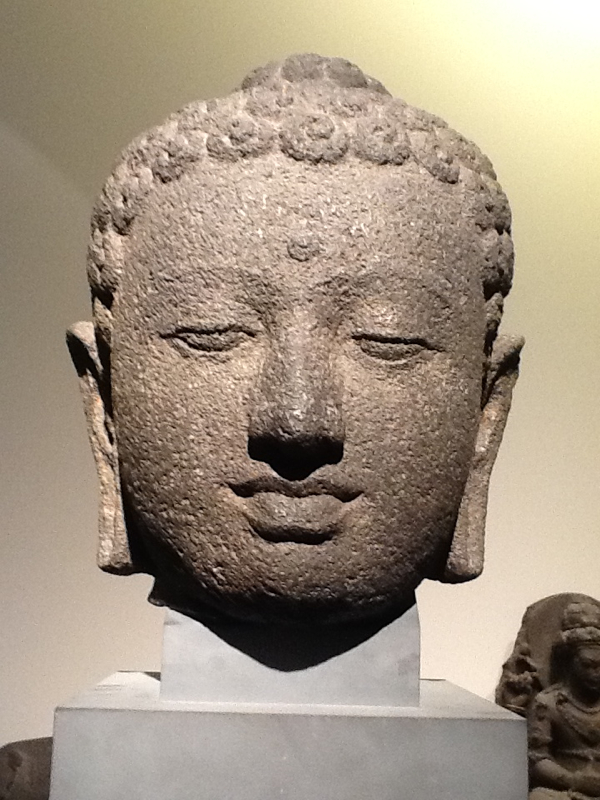
Keep to the middle path, says the Buddha. From Musée Guimet.
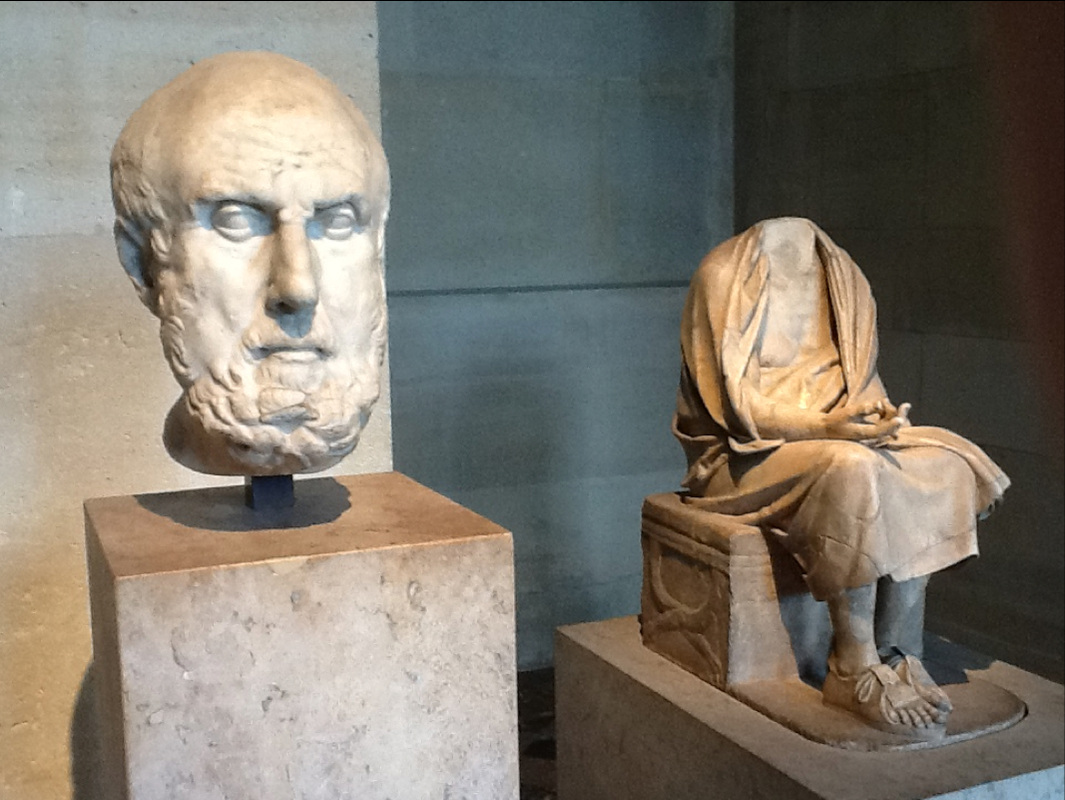
Keep your head on. Portrait and sculpture of Demosthenes, Greek section, The Louvre.
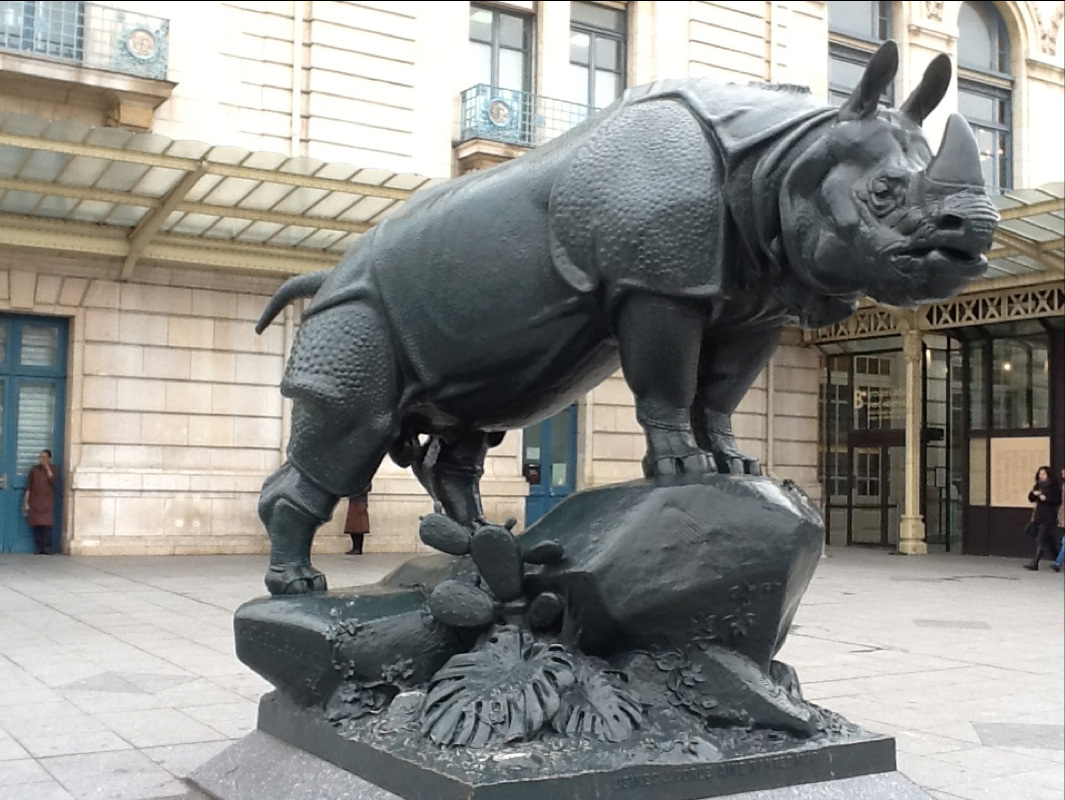
Be vigilant. The rhino of Musee d'Orsay.
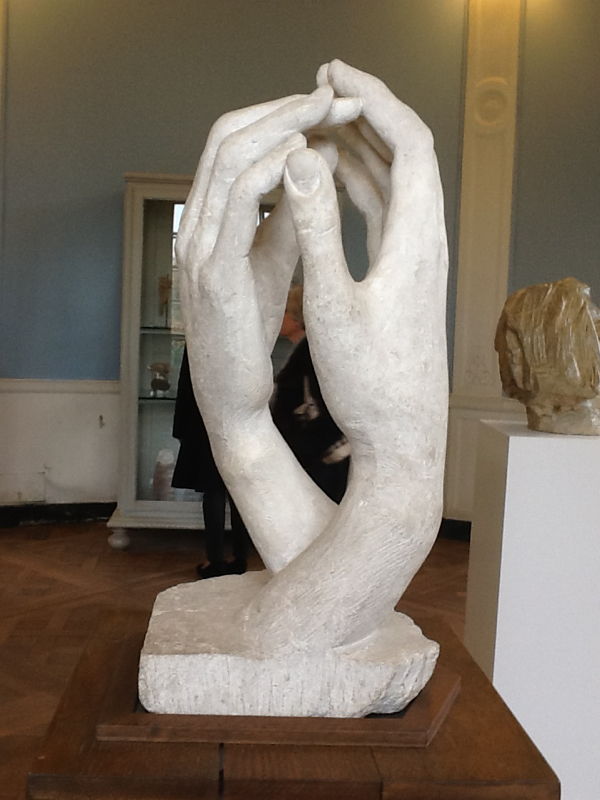
Keep it there. The Cathedral by Auguste Rodin, Musée Rodin.
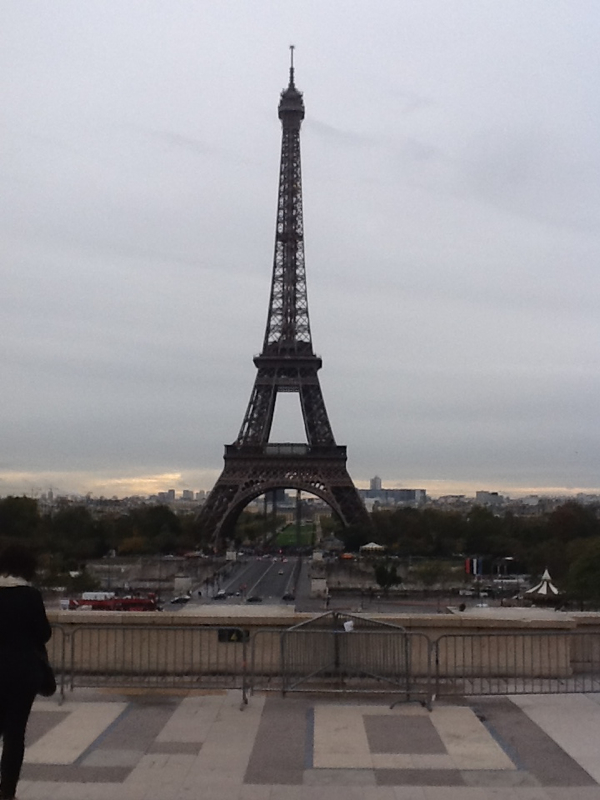
Believe me this wont go away. Take your time.
|













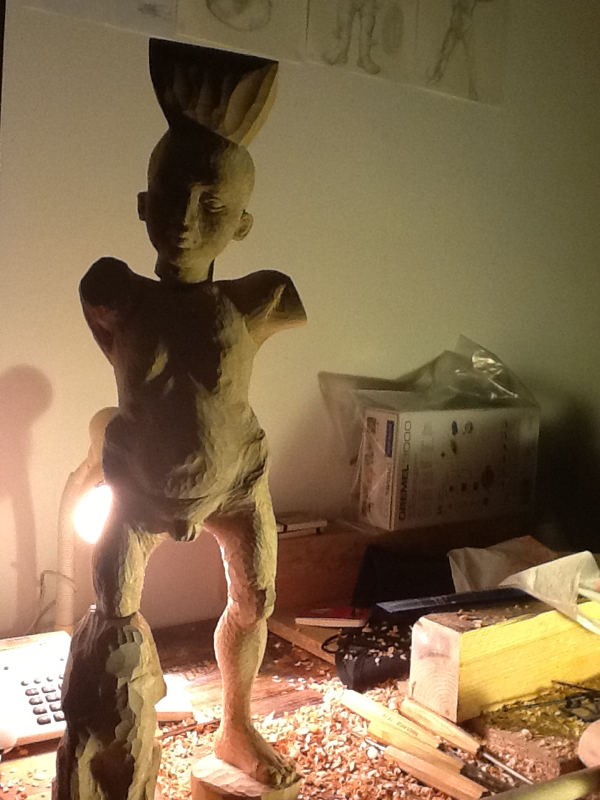
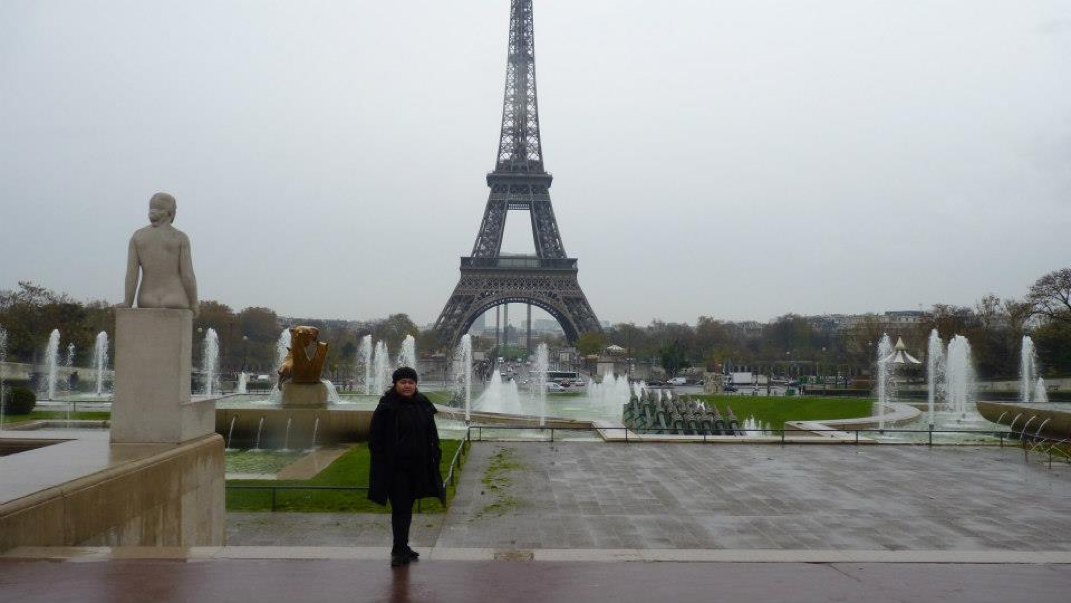
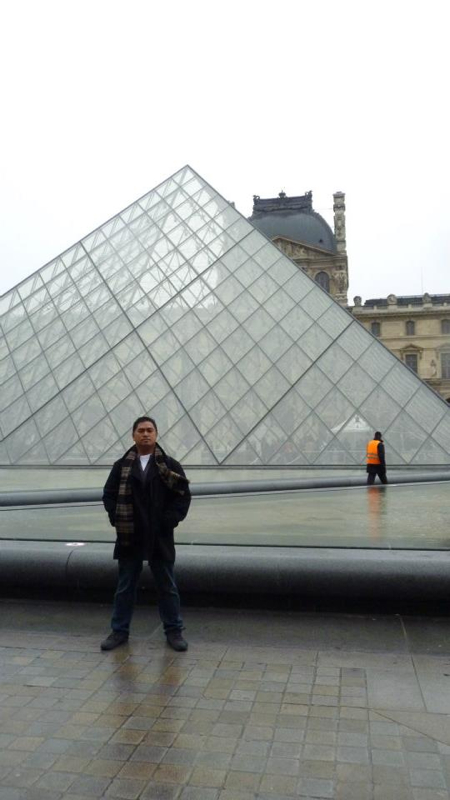
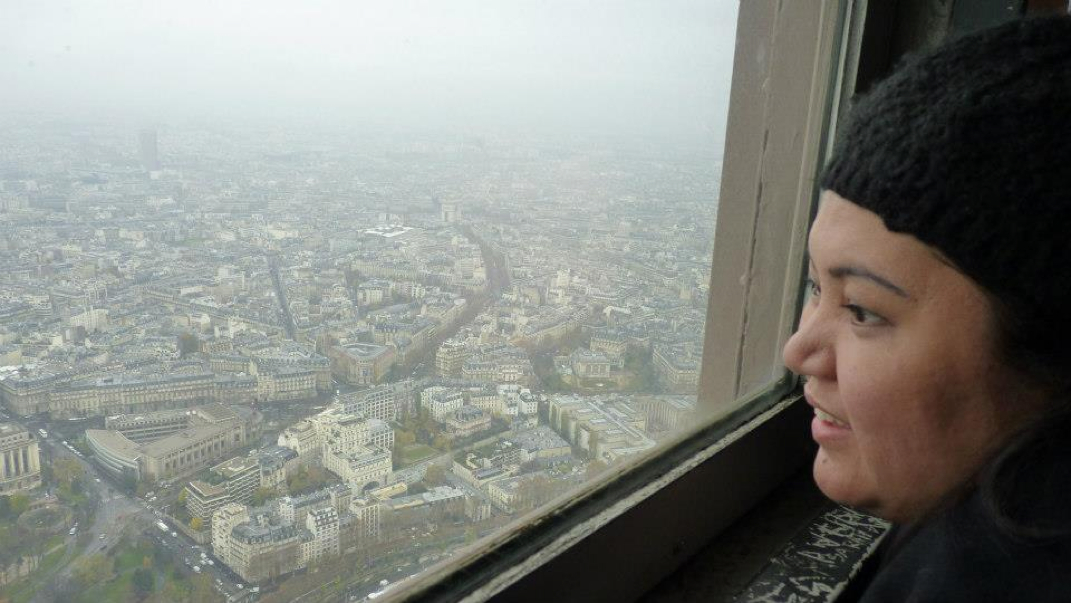
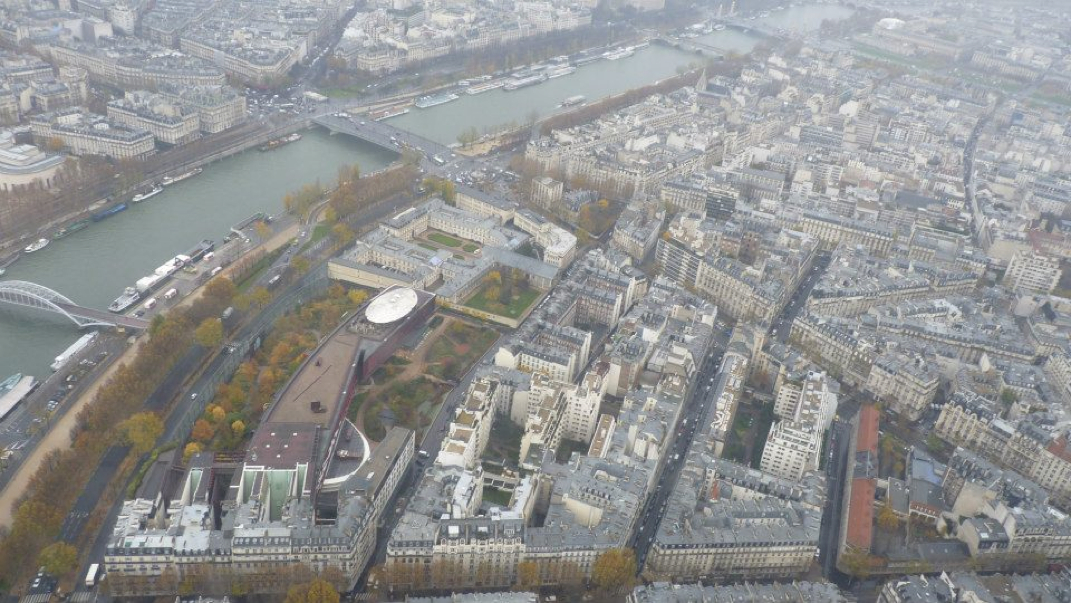
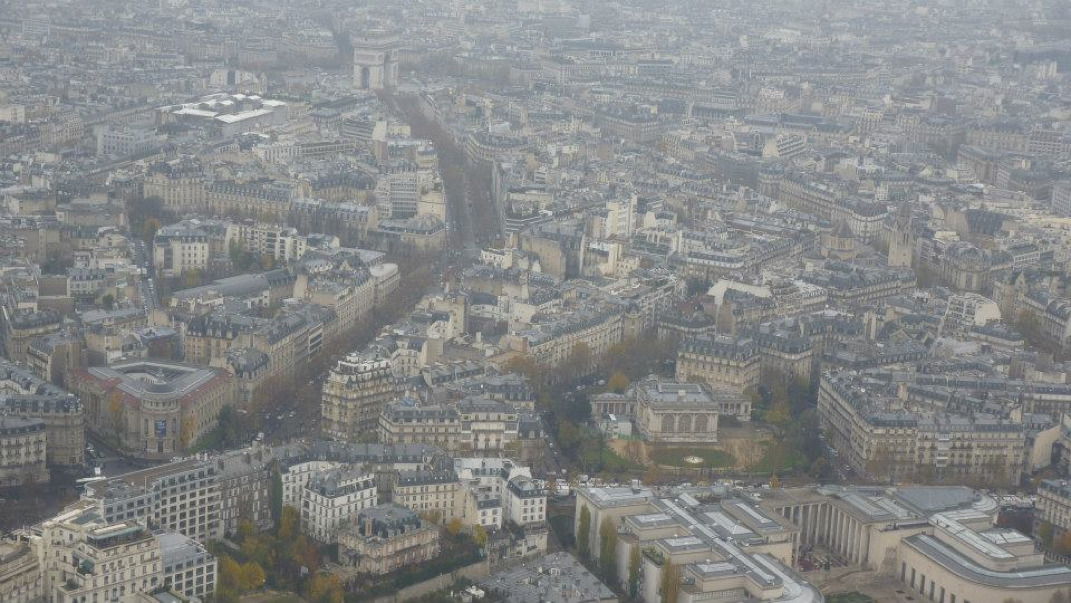





 RSS Feed
RSS Feed